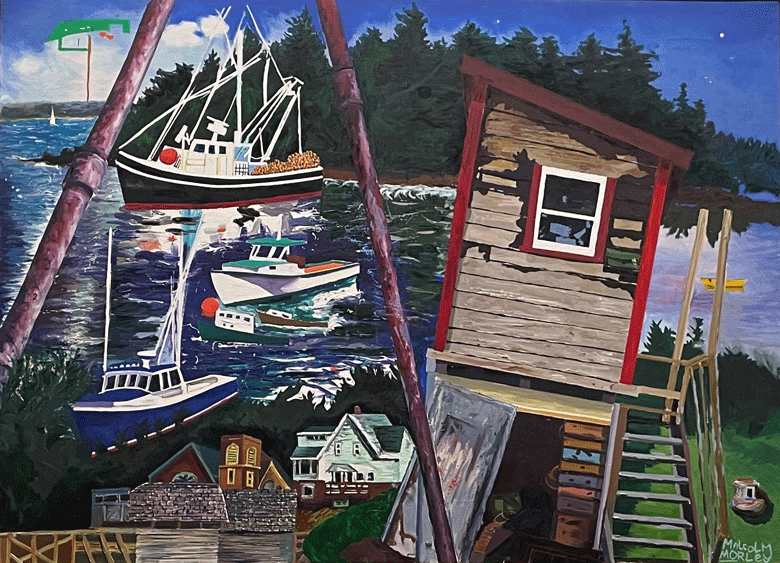Sometime in the late 1980s, the British-American painter Malcolm Morley (1931-2018) and his Dutch-born wife, Lida (Kruisheer) Morley, arrived in Port Clyde to take a watercolor class with local artist Gary Akers. While they only stayed for the first session, they loved the village and ended up renting a small cottage and then, in 1989, buying the former Chet Davis house on Cold Storage Road.
Feeling as if they were in a fishbowl, the couple moved to a house on Ballfield Road, on a hill overlooking the harbor. For a decade they summered there nearly every year, driving up from Long Island, New York, in May accompanied by a Ryder truck filled with painting supplies.
“Sometimes Malcolm would come with an already planned painting and do it there,” Lida Morley recalls. “That way he wasn’t necessarily locked into Maine imagery.”
Morley created several works inspired by his coastal surroundings, including oil paintings, watercolors, and sculpture. The most directly related to his seasonal home is Port Clyde (1993). Rendered with expressive brushwork, this collage-like view of the working harbor with Raspberry Island as backdrop features various boats, buildings, and a tilting shed.
At the time he painted Port Clyde, he was at the top of the art world.
Steven Davis, who lobstered out of Port Clyde from 1960 to 2009 and whose family’s home Morley bought, helped identify some of the imagery. The “little brown church” is the Advent Christian Church, which he attended as a child and where his mother played the piano.
The red-trimmed shed was the office for a cousin’s lobster-buying business.
Other Port Clyde residents offered IDs and shared memories of Morley after the painting appeared on Facebook. Glen Libby, owner of Fresh Catch Port Clyde, identified the boat rigged for seining in the upper left as Pride and Joy owned by Fred Stimpson.
Several people noted that the “mint-green” house belongs to retired fisherman Carl Schwab. Dick Nixon, who did all the construction on the Morley house and studio, recalled taking the painter out in the harbor “so he could sketch some of the lobster boats from different angles.”
Lida Morley explained her husband’s approach vis-à-vis Port Clyde.
“What Malcolm did with that painting he often did throughout his life: take a little bit of here and a little of there and put it together in a fictional landscape that looks coherent, but when you go and look at it, you won’t be able to find it—except for the bits and pieces.”
The Morleys befriended a number of Port Clyde residents, including Norman Tate, a retired cartoonist for Disney (he worked on Pinocchio and Fantasia, among other films). Peter Spectre called Tate “the most famous—and joyous—sailor in Port Clyde” when he died in 2007.
They also dined with Andrew Wyeth. “They got along well,” recalls Lida, “they were quirky.”
Their neighbors, the Olivieri family, became friends.
“Malcolm and Olivieri senior were very close because he was a musician and Malcolm was a painter,” Lida recalls. Morley did the cover and illustrations for Carol Olivieri Schulte’s book 600 Crises or Growing Up Italian.
A granddaughter, Oceania Olivieri, worked as an assistant, cleaning brushes and sanding airplane wings. At the time Morley often affixed model planes to his canvases. One of them was based on the Fokker DR-1 flown by Manfred von Richthofen, the Red Baron, in World War I. Morley had seen a replica of it at an airshow at the Owls Head Transportation Museum and incorporated it in several paintings.
An artist with a checkered past—he served time in a U.K. reform school and prison before finding his way to art school and subsequent fame as a painter in New York City—Morley became a U.S. citizen in 1991 at age 60.
At the time he painted Port Clyde, he was at the top of the art world. He had won the first-ever Turner Prize in 1984 and received the Skowhegan School of Painting and Sculpture’s prestigious medal in painting in 1992. A show of his watercolors, including a couple of Port Clyde pieces, circulated around the world in 1991-1992.
In 2001, the Morleys sold their Port Clyde home to another painter, Kenneth Noland (1924-2010), and his wife, writer and editor Paige Rense (1929-2021). They never returned to Maine.
Lida thought about it, “but it was painful in a way because it was so idyllic,” she says, “and we had such a wonderful time.” Her husband was “so inspired, especially by the light on that peninsula,” she remembers, “and he loved boats and lobster boats and clunky metal rickety things, so it was like an ice cream store for a kid—there were so many flavors.”
Many thanks to Lida Morley for filling in some of the details of her and her husband’s Maine forays and to the members of I Love Port Clyde America on Facebook who responded to my queries. It takes a village to appreciate a painting.
Carl Little’s latest book is Mary Alice Treworgy: A Maine Painter.





